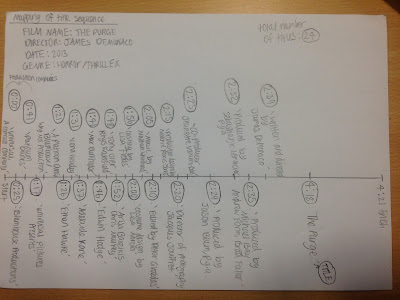Preliminary Task Reflection
This was our given task for the preliminary:
- Continuity task involving filming and editing a character opening a door,walking across and sitting down in a chair opposite another character, with whom she/he then exchanges a couple of lines of dialogue. The Preliminary task must include a match on action, shot-reverse-shot and adhere to the 180 degree rule to ensure continuity.
This task was given to us in order for us to gain some experience in filming and editing and develop our skills so that when we come to completing our main task we can be more advanced. We were able to also include some of the camera shots and angles that we learnt during our lessons, and create a narrative to the story, which we hadn't done before.
Before starting this task, we first made a mind map with a few ideas, and then decided upon a final decision for what our story would be. We then created a shot list and storyboard so that when we came to filming, we knew what we would film and in what order. This gave us more control over what we were doing.
We were able to film the preliminary task within around 40 minutes during a media lesson. Overall the filming of the task went quite well. However, whilst editing, we found that the sound was not very audible. This made it hard to understand what the characters were saying at times and is something that didn't go well in regards to this task.
Additionally, we didn't film an accurate shot-reverse-shot, which was something that could have been improved. On the other hand, our continuity was something that we were happy with, as there is not delay in our scenes and everything flows nicely.
If I were to go back and film it all again, I would make sure that the actresses that we used were louder when having their dialogue, so it is more audible than it is in the preliminary task. I would also maybe make the non-copyright soundtrack that we used a little bit quieter so that the dialogue is more audible. As well as this, I would produce a more accurate shot-reverse-shot so that the continuity of the task is a little bit better, although there was nothing too bad about it.
In the final task, I will make sure to take these factors into account and maybe use some more impressive camera techniques with the skills that I've learnt so far. For example, different camera angles and shots, adding a soundtrack, and making my sound easily audible so that the audience doesn't struggle to hear it.










